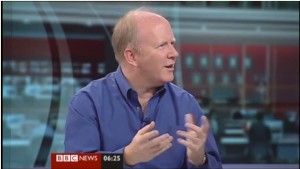On Friday, Business Weekly (a small local publication not to be confused with BusinessWeek) published a most unfortunate article about recent changes at DisplayLink, entitled ‘DisplayLink Chairman Says Company Needed to Grow Up‘. Here’s an extract:
Founders Dr Andrew Fisher and Tim Glauert left the company after what the chairman described as an amicable discussion about the future direction of the business.
A number of battle-hardened industry veterans were drafted in, among them Paul Murphy as European managing director.
and
O’Keeffe said: “”I am always a little nervous about jettisoning founders of a company because they can be very passionate about the business and you have to look at various angles.
“”It’s often the nature of startup companies to involve themselves more with the R & D than hard commercial sales and both Tim and Andy are bright, creative engineers. To put it simply, we needed to become a proper grown-up business and get away from the research cycle. We had a discussion and felt it best to part company.
This is, to put it bluntly, outrageous.
It is hard not to read between the lines a very strong suggestion that the company has had difficulties up to now because of a couple of recalcitrant founders, and, now that they have gone and the investors and battle-hardened veterans are in control, everything will be OK.
Now, I have been interviewed a couple of times by Business Weekly in the past, and have considered them as a bit better than your average local rag. And I have reason to believe that Graham O’Keeffe is an honourable man. So I will do them both the favour of suggesting that this is a tragic breakdown of communication tied to a single rather irresponsible journalist’s reporting, which could, if unchallenged, do great damage to the careers of two of the nicest, smartest, most inventive people I know, who have poured many years of their lives into creating a company for the benefit of these same investors.
So let me try to set the record straight here.
Martin King and I founded DisplayLink, and I was the CEO for the first couple of years. Having hired an excellent replacement CEO, we moved on to our next startup project. Tim and Andy were there right from the start, and built the core technology on which DisplayLink still depends, and have been with the company ever since. DisplayLink would not be what it is today without them, and a considerable number of people have them to thank for their jobs and livelihood.
Company and investor press releases are, however, an interesting branch of mythology which is worthy of closer literary study. One theme which can often be traced in this genre is the idea that founders single-handedly make or break the company. So it’s very convenient for the VCs to be able to tell the right story about them.
And so it was that, after Martin and I left, Andy and Tim were given the title of Founders, and Martin and I were expunged from the record. I was consulted about this – at least about the first part – and readily gave my approval. Andy and Tim rightly deserved that status from the start, and the company website could proudly boast the ongoing enthusiastic involvement of the Founders.
At least while it was convenient for them to do so.
In this article, however, we see another rather different clichéd plot theme in high-tech startup mythology, about how everything turned for the better after the company finally got rid of those difficult Founders. I would have credited even Business Weekly with a little more imagination than that. You can read the history of Cisco and others to see earlier examples of this theme in the literature.
However, I am in the interesting position of still having many links into DisplayLink at all levels of the company, and yet am under no contractual obligations to toe the party line. So I can clearly state, when others might find it more difficult, that nothing I hear from inside the company would in any way suggest that Tim and Andy are at all responsible for the somewhat rocky ride it has had recently and the budgetary constraints that have forced the company to let them, and a lot of other good people, go.
Some may consider the very difficult market conditions at present. And others may notice a rather surprising fact: that the article completely fails to mention the recent departure of the latest CEO: a disastrous appointment forced on the company by the investors some while ago and yet, despite his departure at about the same time as Tim and Andy, mysteriously absent from the latest press releases….
I shall point no fingers at anyone, but leave the reader to ponder whether it is really likely that Tim and Andy’s enthusiasm for forward-thinking R&D has been the source of any difficulties. Or whether, for example, people who were actually on the board of directors might have considered doing the honourable thing and shouldering some of the blame, rather than finding scapegoats.
Sigh.
Well, DisplayLink has many very good, very smart people remaining, and some great technology, and I wish the company all the best for the future, even though it has lost some of its brightest stars.
And let me state for the avoidance of any doubt that if I ever have the chance of working with Tim & Andy again I will jump at it. And I would strongly recommend any other technology company to do the same.
And people, please remember that wise old saying which you should repeat to yourself every single morning while brushing your teeth…
Don’t believe what you read in the papers.
Note: I have consulted none of the people mentioned before writing this article. The opinions expressed here are entirely my own – though I have reason to believe they are echoed by many.
Update, just a few hours later: Good! The contents of my inbox this morning confirm that I am indeed very far from being alone in these views.




 Today’s thought-provoking quotation comes from The Knight Foundation’s John Bracken:
Today’s thought-provoking quotation comes from The Knight Foundation’s John Bracken:


Recent Comments